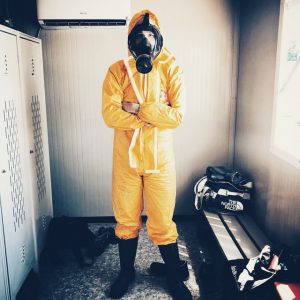Biological Hazards are referred to the organic matters produced by the organisms or even the organisms itself that can be harmful to the health of humans. The types of biological hazards include bacteria, parasites, viruses and fungi. These three are most dangerous of all as they can enter into your body through transmission or even via respiratory system. It can even enter into your body through contaminated fluids and objects. There are mainly three types of biological hazards – allergy, infections and poisoning.
Types of Biological Hazards
Post hazard health problems
Because of the biological hazards, there can be many health problems. These can be hepatitis A, B and C along with that one can suffer from fever, tuberculosis, cholera, influenza etc. All these diseases are spread by virus, bacteria, protozoa and fungus. These biological hazards can be mainly encountered in the chemical laboratories or microbiological labs. Thus, safety measures must be taken to avoid the biological hazards or the post hazard health problems. Some serious issues like avian influenza, AIDS or HIV, histoplasmosis and Lyme disease can occur.
Cleaning tips & control measures
As soon as any biological hazards take place, it is important take the right measure immediately and to clean the entire area properly. If you are not aware of how to start cleaning and eliminate the sources of contamination for preventing the effect of this biological hazards, here are some tips for you:
Tip #1: Take proper protection before cleaning
You must take proper protection before you can clean the area. Thus, you will need masks, gloves, eye shields, shoe covers, face shields and protective clothing. All these are important to ensure best safety while cleaning.

For protecting your respiratory system from getting affected by the hazards you must use masks that cover your nose and mouth properly. You can use the surgical masks that come with 3 layers of non-woven fabrics. Also, you can use higher level respirators and disposable masks while cleaning.
Tip #3: Have proper equipment
Use the right equipment to eliminate the contaminated fluids and objects safely and carefully. With the right tools and equipment, you can effectively clean the entire premise efficiently.
Tip #4: Sterilizing the place is important
Sterilization of the affected area is important to eliminate the bacteria or viruses to cause further contamination. This will also disinfect the area or the premise without leaving any toxic substance or residuals.
Tip #5: Clean your hands and dispose of the clothes
Clean your hands properly with anti-bacterial soaps to ensure that there is no chance of any contamination. Dispose the gloves, masks and clothes immediately.
Conclusion
You need to follow all these cleaning tips in order to ensure that you are completely safe and secured. These safety measures can help you to clean the affected area efficiently and smoothly. You must not forget that there are risk involved with the types of biological hazards. In case you notice any change in your health and facing discomforts, make sure to call the doctor. You must take proper preventive measures to control the biological hazard. This will make the environment much safer and healthier.
